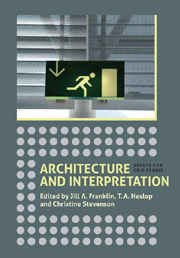Book contents
- Frontmatter
- Contents
- List of Illustrations
- Preface: In Appreciation
- List of contributors
- 1 Introduction
- Incitements to Interpret in Late Antique and Medieval Architecture
- Authors and Intentions
- Architecture beyond Building
- 266 Innovation and Traditionalism in Writings on English Romanesque
- 284 Why Medieval Ireland Failed to Edify
- 306 The Chapel of the Hospital of Saint-Jean at Angers: Acta, Statutes, Architecture and Interpretation
- 315 Sealed Architecture: City Seals, Architecture and Urban Identity in the Northern Netherlands, 1200–1700
- 333 Style and Geography: Struggles for Identification in the Later Nineteenth Century
- 343 The Dome of the Rock: From Medieval Symbol to Modern Propaganda
- 357 Towards a Cultural Geography of Modern Memorials
- 381 Bicycle Sheds Revisited, Or: Why are Houses Interesting?
- Index
266 - Innovation and Traditionalism in Writings on English Romanesque
from Architecture beyond Building
Published online by Cambridge University Press: 05 April 2013
- Frontmatter
- Contents
- List of Illustrations
- Preface: In Appreciation
- List of contributors
- 1 Introduction
- Incitements to Interpret in Late Antique and Medieval Architecture
- Authors and Intentions
- Architecture beyond Building
- 266 Innovation and Traditionalism in Writings on English Romanesque
- 284 Why Medieval Ireland Failed to Edify
- 306 The Chapel of the Hospital of Saint-Jean at Angers: Acta, Statutes, Architecture and Interpretation
- 315 Sealed Architecture: City Seals, Architecture and Urban Identity in the Northern Netherlands, 1200–1700
- 333 Style and Geography: Struggles for Identification in the Later Nineteenth Century
- 343 The Dome of the Rock: From Medieval Symbol to Modern Propaganda
- 357 Towards a Cultural Geography of Modern Memorials
- 381 Bicycle Sheds Revisited, Or: Why are Houses Interesting?
- Index
Summary
This generation has an innate vice, namely, that it can accept nothing which has been discovered by contemporaries; as a consequence, when I wish to publish something I myself have discovered, I ascribe it to someone else, saying: ‘A certain man, not I, has said …’
Adelard of Bath (c. 1080–c. 1160)GIVEN THAT Eric Fernie has always shown an interest – not universal among medievalists – in the modern, this contribution to a volume in his honour offers an investigation of the concept of innovation, or novelty, in Romanesque architecture in England. Three approaches suggested themselves, namely a review of the place of what has been regarded as innovatory in English Romanesque in the historiography of medieval architecture; an investigation of what appears to have been picked up as an innovation worth repeating in England in the eleventh and twelfth centuries; and finally, as a preliminary to this, a look at the written sources from the eleventh and twelfth centuries which make claims for novelty or originality in English architecture, a small group of texts that has frequently been invoked to show the impact of the post-Conquest building boom on contemporary observers. In the event, this written material proved sufficiently fertile to provide the whole matter of the paper, and while this by no means pretends to be a comprehensive survey of all the relevant contemporary references, by examining the contexts in which they appear, it enables a number of conclusions to be drawn about their nature and their aims.
- Type
- Chapter
- Information
- Architecture and InterpretationEssays for Eric Fernie, pp. 266 - 283Publisher: Boydell & BrewerPrint publication year: 2012



